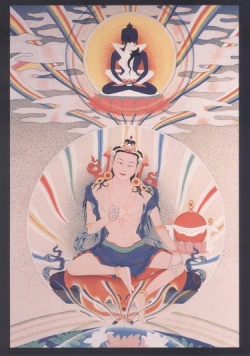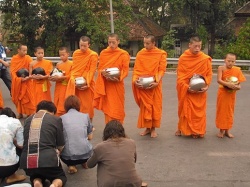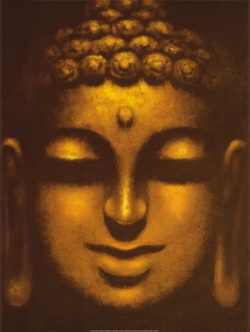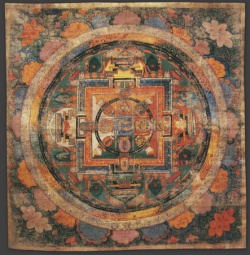The Spread of Buddhism Among the Chinese
This is part of a series that examines Chinese belief systems: how people think and behave, philosophically and religiously. In understanding Chinese belief systems, it is important not to take terms at face value; the word "religion" (zongjiao), for example, did not exist in the Chinese lexicon until the 19th century. Appreciating the complexity of Chinese belief systesm is crucial to understanding the forces that helped shape China.
Buddhism, a cultural system of beliefs and practices based on principles of compassion and non-attachment, originated in the sixth century BCE in what is today Nepal. It was brought to China by Buddhist monks from India during the latter part of the Han dynasty (ca. 150 CE) and took over a century to become assimilated into Chinese culture.
One of the key forces of Buddhism’s success was Daoism. To help the Chinese comprehend Buddhist concepts, Buddhists borrowed ideas from Daoism via the Chinese language. Both Buddhism and Daoism benefited from this exchange. Daoists expanded their ideas about the cosmos and ways to structure their monastic orders. Buddhists gained a lexicon that made it easier to teach their tradition.
Over time Buddhism became a popular force in the lives of the Chinese, from the common people to the emperor himself. In fact, by the sixth century, Buddhism rivaled Daoism in popularity and political influence. It was during this time, and over the course of the next three centuries, that major schools of Chinese Buddhism formed. Two schools that retain their influence today are Pure Land Buddhism and Chan (Zen) Buddhism. Even in mainland China, where religion is often suppressed by the government, there are practitioners of these two schools of Chinese Buddhism.
Buddhism in China–as is the case with religious Daoism and Confucianism–also underwent many changes throughout the country’s history and was varied in its social and religious manifestations and philosophical beliefs. Most scholars think of Buddhism as many Buddhisms. In the so-called classical period of Buddhism in China (Tang dynasty, 618–907 CE), there were a number of schools of Buddhism that taught and promoted their own philosophies and meditation practices. The Huayen and Tiantai schools, for instance, varied in philosophy, location, and political influence. The teachings of various schools influenced and were adapted by Korea and Japan.
One of the most popular figures in Chinese Buddhism is the Bodhisattva Guanyin (the one who perceives the laments of the world–Guanshiyin). Having originated from Indian Buddhism as a superior being who aids the suffering of the world, Guanyin has become a key figure in the devotional practices of Chinese Buddhists and Daoists alike.
During the third century B.C., Emperor Asoka sent missionaries to the northwest of India, that is, present-day Pakistan and Afghanistan. The mission achieved great success as the region soon became a centre of Buddhist learning with many distinguish monks and scholars. When the merchants of Central Asia came into this region for trade, they learnt about Buddhism and accepted it as their religion. By the second century B.C., some central Asian cities like Kotan, has already become important centres for Buddhism. The Chinese people had their first contact with Buddhism through Central Asians who were already Buddhists.
When the Han Dynasty of China extended its power to Central Asia in the first century B.C., trade and cultural ties between China and Central Asia also increased. In this way, the Chinese people learnt about Buddhism so that by the middle of the first century C.E., a community of Chinese Buddhists was already in existence. As interest in Buddhism grew, there was a great demand for Buddhist texts to be translated from Indian languages into Chinese. This led to the arrival of translators from Central Asia and India. The first notable one was Anshigao from Central Asia who came to China in the middle of the second century. With a growing collection of Chinese translations of Buddhist texts, Buddhism became more widely known and a Chinese monastic order was also formed. The first known Chinese monk was said to be Anshigao's disciple.
The early translators had some difficulty in finding the exact words to explain Buddhist concepts in Chinese, so they often used Taoist terms in their translations. As a result, people began to relate Buddhism with the existing Taoist tradition. It was only later on that the Chinese came to fully understand the teachings of the Buddha.
After the fall of the Han Dynasty in the early part of the third century, China faced a period of political disunity. Despise the war and unrest, the translations of the Buddhist texts continued. During this time, both foreign and Chinese monks were actively involved in establishing monasteries and lecturing on the Buddhist teachings.
Among the Chinese monks, Dao-an who lived in the fourth century, was the most outstanding. Though he had to move from place to place because of the political strife, he not only wrote and lectured extensively, but prepared the first catalogues of them. He invited the famous translator, Kumarajiva, from Kucha. With the help of of Do-an's disciples, Kumarajiva translated a large number of important texts and revised the earlier Chinese translations. His fine translations are still in use to this day. Because of political unrest, Kumarjiva's disciple were later dispersed and this helped to spread Buddhism to other parts of China.
The Establishment of Buddhism in China: From the beginning of the fifth century to around the end of the sixth century, northern and southern China came under separate rule. The south remained under native dynasties while the north was controlled by non-Chinese rulers. The Buddhist in southern China continued to translate Buddhist texts and to lecture and write commentaries on the major texts. Their rulers were devout Buddhists who saw to the construction of numerous temples, participated in Buddhist ceremonies and organised public talks on Buddhism.
In northern China, except for two short periods of persecution, Buddhism flourished under the lavish royal patronage of rulers who favoured the religion. By the latter half of the sixth century, monks were employed in government posts. During this period, Buddhist art flourished, especially in the caves at Dun-huang, Yun-gang and Long-men. In the thousand caves at Dun-huang, Buddhist paintings covered the walls and there were thousands of Buddha statues in these caves. At Yun-gan and Long-men, many Buddha images of varying sizes were carved out of the rocks. All these activities were a sign of the firm establishment of Buddhism in China by the end of this period.
The Development of Chinese Schools of Buddhism: With the rise of the Tang Dynasty at the beginning of the seventh century, Buddhism reached out to more and more people. It soon became an important part of Chinese culture and had great influence on Chinese Art, Literature, Sculpture, Architecture and the Philosophy of that time.
By then the number of Chinese translations of Buddhist texts had increased tremendously. The Buddhist were now faced with the problem of how to put their teachings into practice. As a result, a number of schools of Buddhism arose, with each school concentrating on certain texts for their study and practice. The Tian-tai school, for instance, developed a system of teaching and practice based on the Lotus Sutra. It also arranged all the Buddhist texts into graded categories to suit the varying aptitude of the followers.
Other schools arose which focused on different areas of the Buddha's teachings. The two most prominent schools were the Ch'an and the Pure Land schools. The Ch'an school emphasized the practice of meditation as the direct way of gaining insight and experiencing Enlightenment in this very life. (see link)
The Ch'an School in China
The Pure Land school centres its practices on the recitation of the name of Amitabha Buddha. The practice is based on the sermon which teaches that people could be reborn in the Western Paradise (Pure Land) of Amitabha Buddha if they recite his name and have sincere faith in him. Once in the Pure Land, the devotees are said to be able to achieve Enlightenment more easily. Because of the simplicity of its practice, this school became popular especially among the masses throughout China.
Further Development of Buddhism in China: In the middle of the ninth century, Buddhism faced persecution by a Taoist emperor. He decreed the demolition of monasteries, confiscation of temple land, return of monks and nuns to secular life and the destruction of Buddha images. Although the persecution lasted only a short time, it marked the end of an era for Buddhism in China. Following the demolition of monasteries and the dispersal of scholarly monks, a number of Chinese schools of Buddhism ceased to exist as separate movements. They were absorbed into the Ch'an and Pure Land schools which survived. The eventual result was the emergence of a new form of Chinese Buddhist practice in the monastery. Besides practicing Ch'an meditation, Buddhist also recited the name of Amitabha Buddha and studied Buddhist texts. It is this form of Buddhism which survives to the present time.
Just as all the Buddhist teachings and practices were combined under the one roof in the monasteries, Buddhist lay followers also began to practice Buddhism, Taoism and Confucianism simultaneously. Gradually, however, Confucian teachings became dominant in the court and among the officials who were not in favour of Buddhism.
Buddhism generally, continues to be a major influence in Chinese religious life. In the early twentieth century, there was an attempt to modernize and reform the tradition in order to attract wider support. One of the most well-known reformist was Tai-xu, a monk noted for his scholarship. Besides introducing many reforms in the monastic community, he also introduced Western-style education which included the study of secular subjects and foreign languages for Buddhist.
In the nineteen-sixites, under the People's Republic, Buddhism was suppressed. Many monasteries were closed and monks and nuns returned to lay life. In recent years, a more liberal policy regarding religion has led to a growth of interest in the practice of Buddhism.




